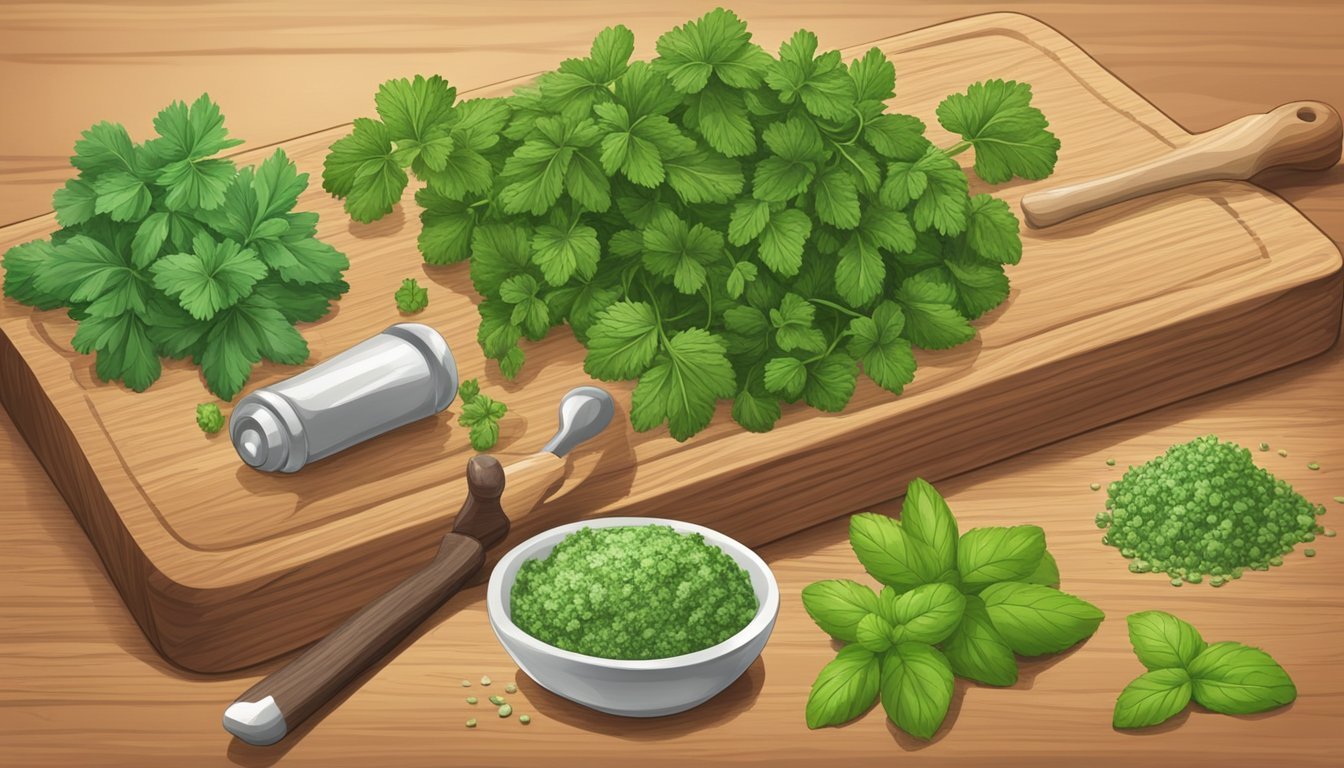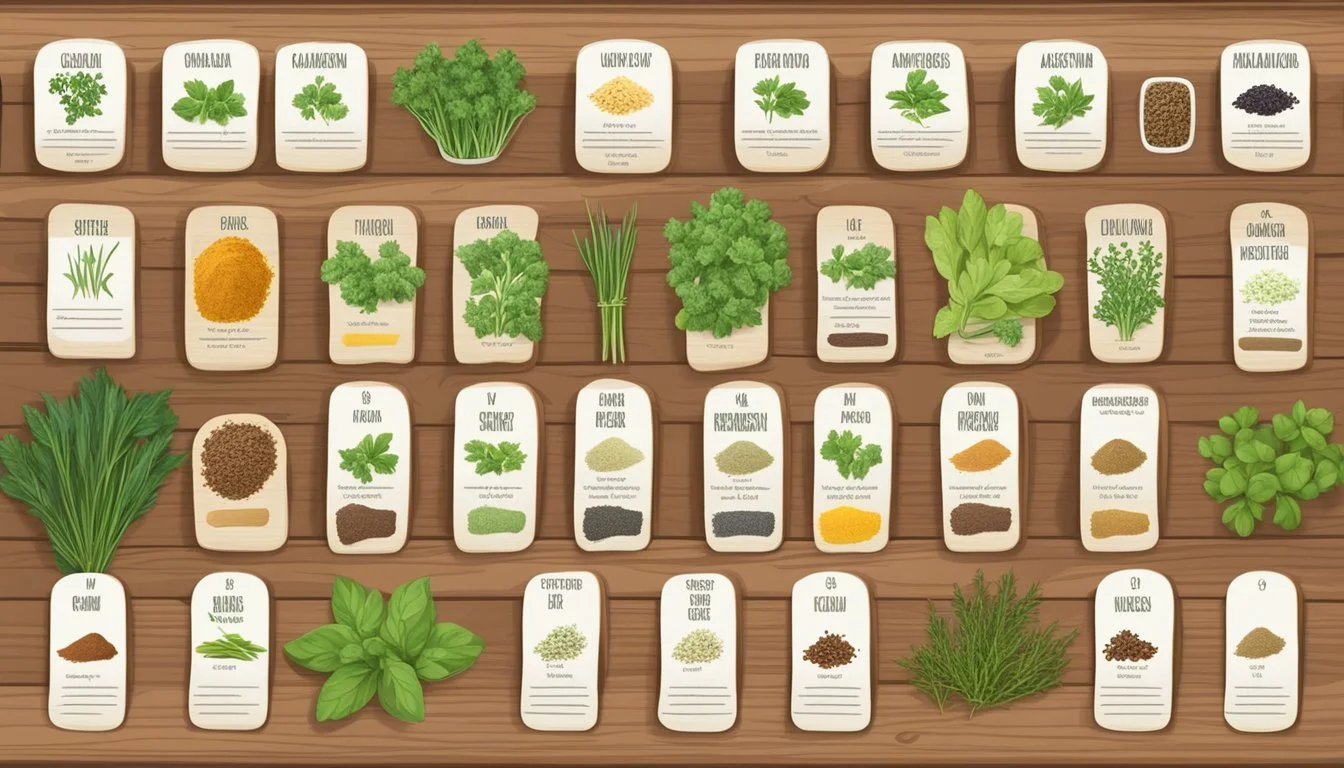Cilantro Substitutes
Top Alternatives for Your Recipes
Cilantro, known for its fresh and citrus-like flavor, is a staple in numerous cuisines around the world, particularly in Latin, Asian, and Indian dishes. However, for some individuals, cilantro has a soapy, unpleasant taste due to genetic differences in taste perception. This can make finding a suitable substitute for cilantro an important task for home cooks and professional chefs alike who wish to cater to different palates or work around cilantro's absence in their kitchen.
Various herbs and spices can serve as cilantro substitutes without compromising the taste of a dish significantly. Parsley, with its similar appearance, is often used as an alternative, although its flavor is milder. In dishes that require the distinct punch of cilantro, Rau ram, or Vietnamese cilantro, can provide a slightly peppery and aromatic taste. For those who are comfortable exploring different flavor profiles, spices such as cumin or coriander—cilantro's dried seed counterpart—can be used, particularly in cooked dishes where their flavors can meld with and complement other ingredients.
Understanding Cilantro
Cilantro, known botanically as Coriandrum sativum, is a widely used herb with a flavor profile that elicits strong responses due to its distinctive genetics.
Cilantro in Cuisine
Cilantro plays an integral role in various global cuisines, from Latin American to Asian. The leaves provide a fresh, citrusy dimension to dishes, while the seeds—known as coriander—are often ground and used for their warmer, spicier flavor. When fresh, cilantro is commonly used as a garnish or incorporated into salsas, curries, and salads to impart a bright flavor note.
Common Misconceptions
One common misconception regarding cilantro involves its taste: a segment of the population perceives its flavor as reminiscent of soap. This reaction is due to a specific olfactory-receptor gene called OR6A2, which can make cilantro's aroma and flavor unpleasant for some, even while others might find it delightful and citrus-like.
Gene Perception of Cilantro OR6A2 Soapy Absent OR6A2 Citrusy, fresh
Cilantro's Distinctive Genetics
The genetic disposition of individuals largely dictates cilantro's reception. Cilantro's distinctive aroma comes from the aldehydes it contains, which are detected differently depending on one's genetic makeup. While cilantro and coriander are from the same plant, the latter refers to the dried seeds which have a significantly different flavor profile, less affected by genetic variance in taste perception.
Best Substitutes for Cilantro
When looking for alternatives to cilantro, it is important to consider the form of cilantro to be substituted – fresh, dried, or seed-based forms. This section offers specific substitutes that closely match cilantro's unique flavor profile in these various forms.
Fresh Herb Alternatives
For those who desire a herb that can be used in place of fresh cilantro, the following are the most suitable options, taking into account taste and aroma:
Parsley: Often used as a garnish, parsley can mimic the appearance and texture of cilantro, though it offers a milder flavor.
Thai Basil: With its hint of licorice flavor, Thai basil brings a similar aromatic quality to dishes.
Rau Ram (Vietnamese Cilantro): This herb is a bit more peppery but shares a similar taste profile with cilantro.
Culantro: A relative of cilantro, culantro offers a more intense flavor, making it a good candidate for cooked dishes.
Dried Herb Alternatives
For recipes calling for dried cilantro, these alternatives can provide a corresponding taste:
Dried Parsley: While more muted in flavor, dried parsley is an available substitute that can visually mimic dried cilantro.
Dried Dill: It lends a different, yet palatable, flavor that works well in certain recipes.
Seed and Spice Alternatives
Cilantro seeds, known as coriander, have a different flavor profile than the fresh leaves. When the recipe calls for coriander seeds or ground coriander, consider these substitutes:
Ground Coriander: Derived from cilantro seeds, it meshes well in recipes for its earthy and tart flavor.
Cumin: Provides a warm, nutty taste distinct from cilantro but can complement the flavors in a dish where cilantro is required. Use sparingly to avoid overpowering the dish.
Herb Pairings and Flavor Profiles
In the realm of culinary arts, one's ability to pair herbs properly can transform a dish's flavor profile. Below are specific herb pairings that emulate the unique taste of cilantro and can serve as substitutes in recipes.
Herbaceous and Spicy Flavors
For those seeking an herb that mimics cilantro's distinctive peppery taste, several options are available. Parsley, with its bright herbal flavor, is a classic alternative that can replace cilantro without overwhelming other ingredients in a dish. It's particularly efficient in recipes where cilantro's spiciness is intended to be subtle. Meanwhile, Thai basil offers an interesting alternative with its slight anise-like flavor, adding a nuanced complexity to Thai and Vietnamese cuisine.
In addition, combining dill and tarragon lends a warmer, subtly spicy flavor, making these herbs useful in dishes where a more European approach is desired. Oregano provides another layer of spicy depth, but due to its potency, it should be used sparingly to ensure balance within the dish.
Citrusy and Tangy Flavors
To capture cilantro's lemony and citrusy undertones, chefs can incorporate herbs like tarragon, which imparts a mild, nuanced tanginess. This makes it suitable for dressings and lighter sauces where a hint of citrus is welcome.
For a more direct substitution, one can introduce lemon or lime zest into the equation. The zest, being the outermost part of the citrus peel, contains oils that provide a concentrated lemony flavor, enhancing the freshness of a dish in a manner similar to cilantro. A light sprinkle over the finished plate ensures the aroma is preserved.
Cultural Considerations and Variations
When seeking cilantro substitutes, it’s important to consider the diverse flavor profiles and culinary practices of different regions.
Latin American Cuisine
In Latin American dishes, cilantro plays a pivotal role, lending its distinct flavor to salsas, guacamole, and beans. Two herbs stand out as substitutes in this cuisine:
Epazote: Known for a strong flavor, it's commonly used in Mexican cooking.
Papalo: Offers a taste combination of citrus, mint, and arugula.
Asian Cuisine
Asian cuisine often utilizes "Chinese parsley," another name for cilantro, for its aromatic quality. A common Asian substitute is:
Rau Ram: Also known as Vietnamese cilantro, closer in taste to standard cilantro and used interchangeably in dishes like salads.
Middle Eastern Cuisine
In the Middle East, the flavor of cilantro is sometimes mimicked using dried spices due to the herb's prevalence in local food. Notable substitutes include:
Herb/Spice Use Case Coriander Seeds Ground coriander can replace dried cilantro, offering a warmer, nutty flavor. Caraway Seeds Though distinct, they can add an earthy note to some Middle Eastern dishes.
Italian parsley is another substitute that can be used across various cuisines, including Middle Eastern, when cilantro is not available, providing a milder taste.
Specific Dishes and Their Substitutes
When cooking, it's crucial to pick the right substitute to maintain the integrity of the dish. The following sections highlight specific substitutes for cilantro in various dishes, from sauces to main courses.
Sauces and Marinades
In sauces and marinades, Thai basil can replace cilantro to impart a similar herby character with a hint of anise. For a pesto or chimichurri, one can easily use parsley as a substitute to achieve a fresh, earthy taste while lacking the citrusy notes that cilantro would provide.
Salsa: In salsa, Thai basil or Italian flat-leaf parsley are good substitutes, particularly to achieve the desired texture and freshness.
Salsa Verde: For salsa verde, try using mint for a refreshing flavor profile, although it will have a distinct difference compared to cilantro.
Salads and Cold Soups
For salads and cold soups, herbs like mint or dill offer a fresh twist, bringing their own unique qualities to the dishes. Potato salad, for example, benefits from the addition of Italian parsley or dill for a subtle but distinct flavor.
Guacamole: Substitute cilantro with chives or green onions to add a mild, onion-like flavor when making guacamole.
Cold Soups: In cold soups, consider using parsley or even a small amount of fresh tarragon to introduce a mild, yet distinct flavor component.
Main Courses
In main courses that require cilantro, such as those with curry powder or garam masala, it's important to use an herb that compliments the spices without overpowering them.
Curry Powder: Add curry leaves as a stand-in for cilantro to maintain an authentic curry flavor.
Garam Masala: Although not an herb, a pinch of this spice mix can mildly mimic cilantro's complexity in heated dishes.
Bold flavors, such as Thai basil, should be used judiciously to prevent them from overwhelming the dish. When adding these substitutes to main courses, chefs should consider their intensity and start with conservative amounts, adjusting to taste.
Alternative Herbs and Their Culinary Uses
In the quest for suitable substitutes for cilantro, a few herbs stand out not only for their flavor profiles but also for their ability to blend into various culinary applications. Here's a closer look at how some of these alternatives can be used in the kitchen.
Parsley and Its Varieties
Parsley is a versatile herb that is commonly utilized in cooking. It comes in two main varieties:
Curly-leaf parsley: Often used for its decorative appearance but it also imparts a mild, herbal flavor which is less pronounced than cilantro.
Flat-leaf parsley: Also known as Italian parsley, it has a more robust flavor and is preferred in cooking for its ability to withstand longer cooking times.
Culinary Uses:
Garnishing: Both varieties serve well as a garnish due to their fresh green color.
Cooking: Flat-leaf parsley is excellent in soups, sauces, and stews.
Substitution: Parsley can replace cilantro in equal amounts in most recipes.
Mint and Its Versatility
Mint is a refreshing herb known for its aromatic quality. There are several varieties, such as peppermint and spearmint, each lending a unique character to dishes.
Culinary Uses:
Fresh: Fresh mint leaves are great in salads, drinks, and desserts for a refreshing twist.
Cooked: Mint can be included in slow-cooked dishes where its flavor subtly infuses the meal.
Substitution: Start with a smaller amount of mint when substituting for cilantro, due to its strong flavor.
Complex Flavor Herbs
Several herbs offer complex flavor profiles and can be used as cilantro substitutes in specific culinary contexts.
Dill: Offers a grassy and slightly anise-like taste; best used sparingly within dips, sauces, and seafood dishes.
Celery Leaves: Provide a bitter and earthy taste; suitable in soups and stews.
Tarragon: Known for its licorice-like flavor; a staple in French cuisine and pairs well with chicken and fish.
Rau Ram (Vietnamese Coriander): Exhibits a peppery, lemony taste; a direct substitute for cilantro in Southeast Asian recipes.
Culantro: Shares a similar taste to cilantro but is much stronger; ideal for Caribbean and Latin American dishes.
Papalo: Another potent herb with a robust flavor, often used in Mexican cooking.
Substitution Tips:
Dill: Use half the amount compared to cilantro.
Vietnamese Coriander: Can replace cilantro in a 1:1 ratio, particularly in Vietnamese and Thai dishes.
By considering these alternatives, chefs and home cooks can adapt their recipes to accommodate personal taste preferences or to experiment with different flavor dimensions in the absence of cilantro.
Cilantro Substitute FAQs
When someone's recipe calls for cilantro and they either don't have it on hand or are catering to a personal preference that dislikes the taste of this distinct herb, it's common to seek substitutes that can provide a similar flavor profile. Below are frequently asked questions regarding cilantro substitutes:
What are the best substitutes for cilantro in dishes?
Parsley: Offers a fresh taste, frequently used for its visual similarity to cilantro.
Dill: With a unique flavor, dill can be used in smaller amounts to prevent overpowering a dish.
Celery leaves: These can mimic cilantro's appearance with a more subtle taste.
Can I use dried herbs as a substitute for fresh cilantro?
Ground coriander: As the seed form of cilantro, it gives a more potent taste. Use sparingly.
Curry powder: Contains ground coriander and other spices, offering a complex flavor.
How does the flavor of substitutes compare to cilantro?
Thai basil: Similar to cilantro but with a licorice undertone.
Vietnamese cilantro (Rau Ram): A bit more peppery but aromatic and a close match.
Papalo: Shares cilantro's flavor, with a stronger kick.
Which cuisine's recipes commonly use cilantro? Cilantro is prevalent in Mexican, South American, Asian, and Indian cuisines. Substitutes should match the specific profile of these varied cuisines while maintaining the dish's integrity.
Are there any considerations for using substitutes? Yes, personal preference and the particular dish being prepared should guide the choice of a substitute. The intensity and distinct taste of each substitute needs to be considered to achieve a balanced flavor.
Storage and Preparation Tips
Storing and preparing cilantro substitutes properly is essential to maintain their flavor and extend their shelf life. The right storage methods differ for fresh and dried herbs, while preparation techniques can vary based on the dish and the substitute used.
Storing Fresh and Dried Substitutes
Fresh Herbs:
Parsley and Dill: Store parsley and fresh dill weed in the refrigerator wrapped in a damp paper towel and placed inside a plastic bag. They typically last up to a week.
Thai Basil: Fresh Thai basil is best kept in a glass of water at room temperature, similar to cut flowers. It lasts longer when the stems are submerged and the leaves are kept dry.
Dried Herbs:
Dried Parsley and Dill: These should be stored in an airtight container in a cool, dark place to preserve their flavor. Avoid moisture to prevent clumping.
Dried Cilantro: Dried cilantro leaves should also be kept in an airtight container away from light and heat. Make sure they're completely dry before storing to prevent mold.
Preparing Substitutes in Dishes
Fresh Substitutes:
Parsley: When using fresh parsley as a cilantro substitute, one should finely chop the leaves and add them to dishes toward the end of cooking to maintain their color and flavor.
Dill Weed: Fresh dill weed has a distinctive taste and should be used sparingly. It's best added to cooked dishes just before serving.
Dried Substitutes:
Dried Parsley: Since dried parsley is less potent than fresh, one might need to adjust the quantity used in recipes. It should be added earlier in the cooking process to allow its flavors to infuse.
Dried Dill: Use dried dill in a smaller quantity than fresh, as the drying process concentrates its flavor. It can be rehydrated in a bit of warm water before use.
Conclusion
When cilantro is unavailable or its flavor is not preferred, suitable substitutes offer culinary flexibility. A knowledgeable choice considers the taste profile and intended use in a recipe. Parsley provides a visually similar appearance and a milder flavor, apt for raw applications like garnishes. In contrast, Rau Ram (Vietnamese cilantro) presents a closer taste to cilantro with a peppery twist, beneficial in salads and flavored foods.
For cooking, coriander seeds — ground or whole — are a go-to, as cilantro and coriander are from the same plant. However, epazote and papalo bring unique Mexican flavors to dishes, while basil, dill, and celery leaves infuse varying degrees of freshness. One's personal preference largely dictates the acceptance of these alternatives.
Choosing an alternative to cilantro revolves around balancing the flavors. For instance, delicate dishes may call for milder herbs, while robust ones can handle the assertive taste of epazote. Here's a quick guide to help in the selection:
Freshness required: Choose parsley or celery leaves.
Citrusy and peppery notes: Opt for Vietnamese cilantro (Rau Ram).
Mexican cuisine authenticity: Consider epazote or papalo.
Cooking with spices: Use ground coriander sparingly due to its potency.
Substituting cilantro does not have to undermine the authenticity or desirability of a dish. With informed selections, one can navigate through various cuisines and flavor profiles, ensuring delightful culinary experiences.





